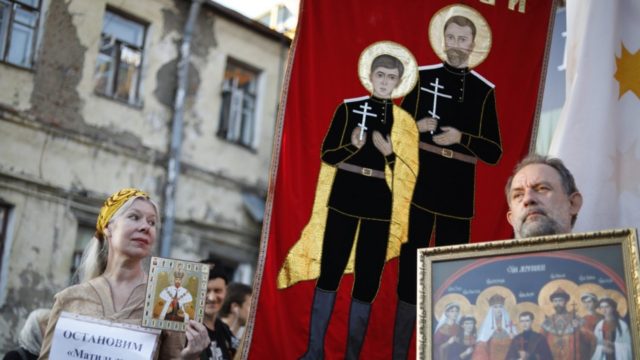
Orthodox Fundamentalists Backed by Russian Siloviki, Scholar Says
Publication: Eurasia Daily Monitor Volume: 14 Issue: 126
By:

Many have wondered why the Russian government has not come down harder on what some are calling “the Orthodox Jihad,” radical groups within the Russian Orthodox Church that, despite opposition from the Moscow Patriarchate, have engaged in various illegal actions—including attacks on movie theaters that plan to show the controversial film Matilda. Some have suggested that the regime does not want to inflame the situation by creating martyrs. But the real reason, local political expert Yekaterina Schulmann says, is that the Orthodox radicals are allies of groups within the Russian force structures (siloviki). And because the behavior of these Orthodox radical groups actually supports the interests of their siloviki allies (notwithstanding the latter’s public pronouncements to the contrary), the “Orthodox Jihad” enjoys a certain level of protection from actions by other officials (Dozhd, October 6).
At the end of the Russian Imperial period, the tsarist secret police actively and notoriously backed the Black Hundreds and other radical Orthodox and nationalist groups in the hopes that such factions could defeat the enemies of the regime. Similarly, at the end of the Soviet period, the KGB created or sponsored various organizations, from the virulently nationalist Pamyat to the Liberal Democratic Party of Vladimir Zhirinovsky, in the expectation that such groups could help that regime survive.
Now, Vladimir Putin’s government appears to be pursuing the same tactics again, selecting from the various radical groups on offer, supporting some while suppressing others, and using the former in the expectation that, whatever officials say in public, these groups will help defend Putin’s rule. It may well be, Schulmann suggests, that in contrast to the past, the authorities are choosing among groups that have arisen on their own rather than creating them out of whole cloth; but the consequences are similar in that they open the way for groups nominally independent of the state to act illegally against those the state opposes or fears. Moreover, the use of such groups is especially attractive to the authorities because they can always be disowned if domestic opposition to them grows too strong (Dozhd, October 6).
As Schulmann points out, there are many Russian Orthodox parishioners, priests and even bishops who are “more radical” than Patriarch Kirill wants and who are fighting against him and his policies “by various means.” The Moscow political scientist further argues that they are able to do so because they enjoy the protection of the Kremlin’s force structures, including but not limited to the Federal Security Service (FSB). Many in the Orthodox Church hierarchy have long been connected with the security organs. These links are not only the result of the Soviet pattern of controlling the selection of all bishops and above; they are also due to existing Church institutions, such as the Synod’s department for work with the siloviki and police, which in the last decade has itself generated many radical leaders such as Archpriest Smirnov (Dozhd, October 6; Windowoneurasia2.blogspot.com, March 16, 2013; September 29, 2017).
All this, of course, is a flagrant violation of the provisions of the Russian Constitution, but it is also an indication of something even worse, according to Schulmann. She argues that “the level of indoctrination among elites of this same Orthodox fundamentalism is much higher than it is in society.” A “radical” difference in the religiosity between Russian elites and the Russian people has always existed—at least as public performance. But today, it has become an abyss, as highlighted by popular opposition to the government’s attempts to return to the Russian Orthodox Church properties seized by the Soviets—including most prominently St. Isaac’s Cathedral in St. Petersburg.
The upper elite of the government bureaucracy “thinks that all the public is just like it is” and will welcome what it proposes on such things. And thus, the Russian elite is delighted when people from within the Orthodox Church are prepared to confirm its prejudices, even when this turns out to be incorrect. In St. Petersburg, for example, the authorities have backed down somewhat precisely because they tried to take these steps openly in the expectation that they would receive public support (Dozhd, October 6).
Now, however, Schulmann’s analysis suggests, at least some among Putin’s siloviki are prepared to use the “Orthodox Jihad” to achieve what has turned out to be more difficult to do above board. That opens the way not only for more outrageously hyperbolic moves, such as the proposals to canonize Duma deputy Natalya Poklonskaya, who leads the anti-Matilda forces (Newizv.ru, October 8), but also for more violence against those who oppose the common program of the “Orthodox Jihad” and the siloviki.
One hopeful sign is visible in all this. Schulmann is a leading expert at the Presidential Russian Academy of Economics and State Service, an institution that often provides early warning indicators about coming changes in Kremlin policy. It thus may be the case that her comments, so disturbing on their face, reflect the fears of others in the presidential administration that the “Orthodox Jihad”–siloviki alliance risks spinning out of control, and they are now prepared to take action to dissolve it.



